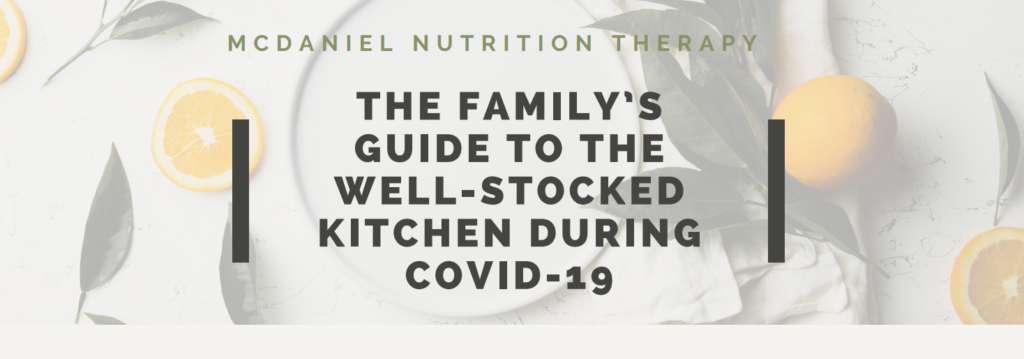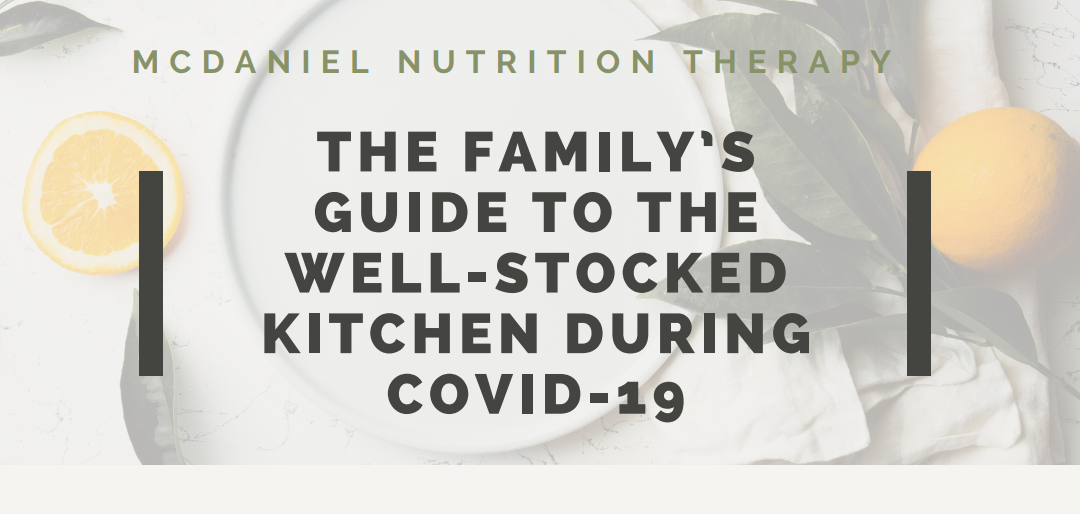As we navigate the new “normal” that COVID-19, families are cooking more and eating out less. With all new journeys into uncharted experiences the number one, most important step is Don’t Panic. Panic leads to irrational decision making. Approaching uncertainty with a plan, though it needs to be fluid and subject to change at a moment’s notice, is far better than no plan at all.
Our FREE gift to you

For those of us who aren’t on the frontlines of healthcare, we’re constantly wondering, what can we do to help? One thing we’re learning is that we all have unique talents and gifts to share. One way we feel we can help is to provide free resources that we normally might charge for. This week, we’re offering two free downloads:
“The Family’s Guide to the Well-Stocked Kitchen During COVID-19”
“COVID-19 Cooking: One Month’s Worth of Sample Meal Plans”
Read Willie’s post below for more COVID-19 cooking strategies!
Blog post by Chef Willie Clayton, MS, RDN

The goal in preparing food for our families during COVID-19 is providing nourishment for growth and good health. However, as social distancing is needed to slow the spread of a sweeping virus getting these foods is more difficult. In order to best prepare, we’re all making changes to our grocery lists and we have to consider questions such as:
- What foods offer the most nutritional bang for its buck?
- How often can I purchase food?
- How long will the foods I buy last?
- Will the foods I meal plan for be available at time of purchase?
- How can I maximize flavor, nutrition and shelf life?
Let’s begin with understanding the shelf-life of foods:
Meal Planning Based on the Shelf-Life of Foods
Luckily, foods come in a variety of forms: fresh, frozen, canned, freeze dried, cured, and dehydrated. When preparing your grocery list use a variety of all foods options but a focus on frozen and canned options to be prepared for long gaps between trips. Your shortest section of your grocery list will be fresh items since you’re shopping less frequently.
Use FIFO: Fresh In, First Out
Fresh items will feel like a treat these days! Use up fresh items such as leafy greens or fresh fish first. If you can’t cook them quickly, freeze them fast to use them later. Fresh foods with a longer shelf life include garlic, onions, potatoes, winter squash (butternut, spaghetti, acorn), apples, oranges, grapefruit, eggs, hard cheeses, yogurt, cottage cheese, nut butter, etc.
Stock Up on Dry, Canned Goods and Frozen Foods
Dry goods, such as dried herbs, spices, seasoning mixes, dried beans and lentils or grains (amaranth, quinoa, millet, farro), rolled oats, rice of choice, condiments, flours, dried fruits (dates, raisins, etc.), pastas can be bought and stored safely for months. Frozen vegetables, fruits, meats and grains also can help round out a nutritious meal plan. Not only do they last longer, they tend to be less expensive.
Having a well-stocked kitchen gives you a sense of security in shaky times. With a lack of certain foods, the desire to avoid grocery shopping, the purpose of this guide is to help you decide which staples to keep on hand during these challenging times. Below you will find the following in our FREE download: The Family’s Guide to the Well-Stocked Kitchen During Covid-19
- Grocery, meal prepping and cooking tips.
- A fridge, pantry, and freezer food checklist to ensure you have a range of fueling foods on hand when you need them.
- A link to shelf-stable produce via ivaluefood.com
- Breakfast, lunch, dinner and snack Ideas based of the food checklist
- 3-part meal-planning strategy
- Two, two-week sample menus
Above all, please know our team of dietitians is here to serve you. Self care has never been more important. Our offices are open virtually with a team of dietitians here to support you in your nutrition and wellness goals. Let us know how we can help!

